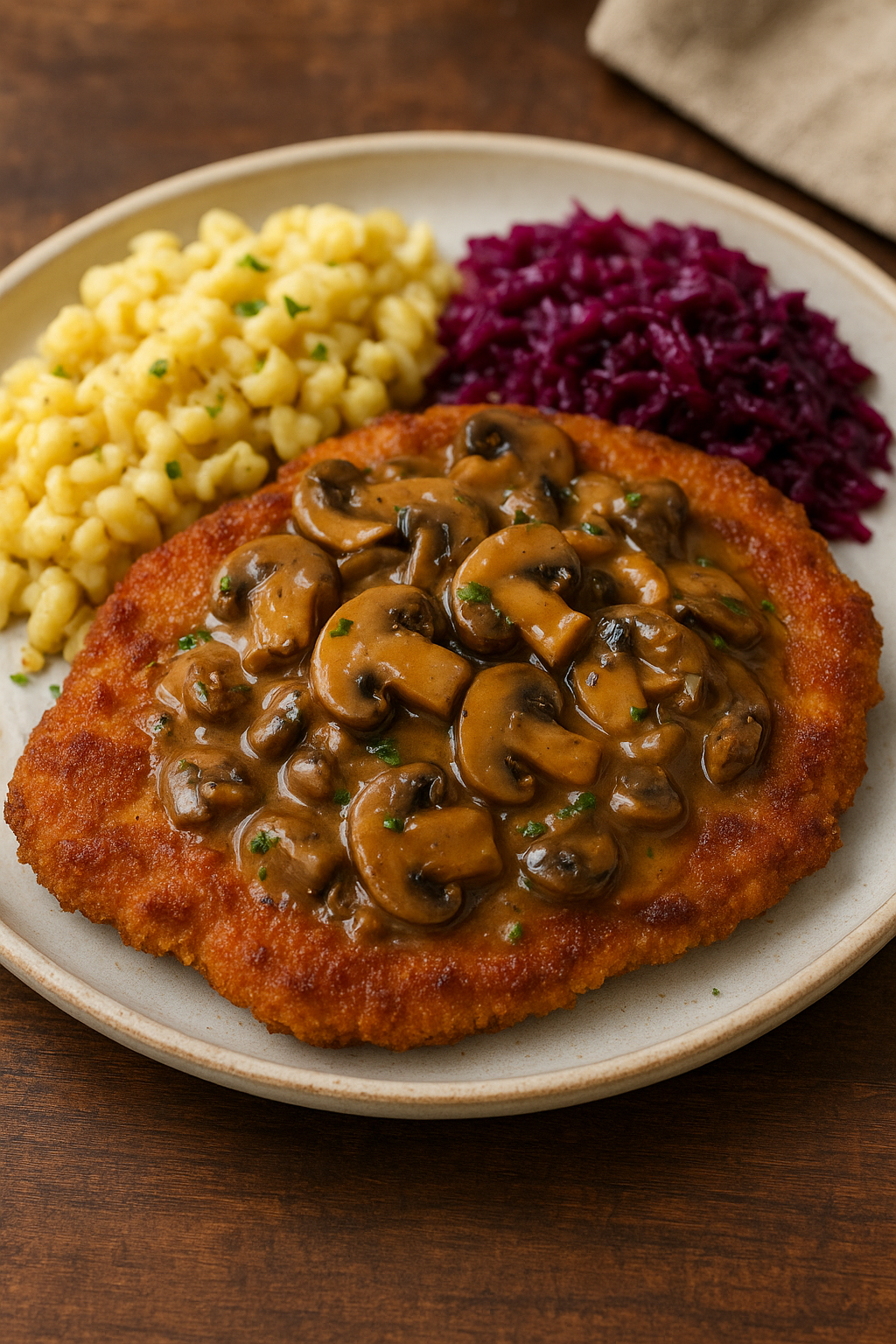JAGERSCHNITZEL AND MUSHROOM SAUCE

Jägerschnitzel and mushroom sauce, or “hunter’s schnitzel,” is a hearty German dish that takes the beloved breaded cutlet to a more rustic, deeply flavorful level. While its cousin, the Wienerschnitzel, is known for its elegant simplicity, Jägerschnitzel embraces a rich, savory mushroom sauce that feels like a taste of the forest. Hence the name. It is especially popular in southern Germany and Austria. That is where woodland ingredients like mushrooms have long been staples of traditional cooking.
At its foundation, Jägerschnitzel begins much the same way as any schnitzel. A pork or veal cutlet, sometimes chicken, is pounded thin, breaded with flour, egg, and breadcrumbs, and fried until golden brown. The real distinction lies in the sauce. Jägersauce (hunter’s sauce). It is a silky, aromatic gravy brimming with mushrooms, onions, and sometimes bacon. It is cooked down with broth, cream, and a splash of wine or brandy. The sauce is seasoned with herbs such as thyme, parsley, or marjoram. That gives it an earthy character that pairs beautifully with the crispy schnitzel beneath it.
TRADITIONAL SERVING STYLE
Traditionally, Jägerschnitzel is served with hearty sides that match its rustic character. Spaetzle, the soft egg noodles of southern Germany, are perhaps the most classic accompaniment. They are good at soaking up the mushroom sauce. Mashed or boiled potatoes, French fries, or buttered noodles are also common. It depends on the region. A side of braised red cabbage or a simple cucumber salad offers freshness to balance the dish’s richness.
While rooted in tradition, Jägerschnitzel and mushroom sauce, has many variations. In East Germany, a different form developed in which the schnitzel was not breaded but rather made from a slice of breaded sausage (Jagdwurst). It was covered with tomato-based sauce, an entirely different but equally nostalgic interpretation.
More than just a meal, Jägerschnitzel and mushroom sauce embodies the spirit of rustic comfort food. It is hearty, warming, and deeply satisfying. It evokes the idea of returning from a long day’s hunt—or simply a chilly day outdoors, to a plate of crispy schnitzel smothered in rich mushroom gravy.
HISTORY & ORIGIN
Jägerschnitzel’s origins are rooted in Germany’s long tradition of rustic, hearty fare. Dishes that drew inspiration from the forests and the hunt. The name itself, Jägerschnitzel, literally means “hunter’s cutlet,” a nod to both the wild game and wild mushrooms that were once common ingredients in rural German kitchens. While today the dish is usually prepared with pork or veal and topped with a mushroom-based sauce, its history is layered and reflects both regional variations and cultural influences over time.
The schnitzel, as a cooking method, pounding meat thin, breading it, and frying it, was popularized in Central Europe in the 18th and 19th centuries. By the late 19th century, schnitzels had become a staple of both home cooking and tavern fare across the German-speaking world. The mushroom sauce, however, reflects a more rustic, “hunter’s” influence. Mushrooms were often foraged from nearby forests, and hunters or rural families would prepare simple gravies using mushrooms, onions, and a bit of stock or cream to accompany meat. Over time, this rustic sauce became paired specifically with schnitzel, and the dish began to be known as Jägerschnitzel.
By the early 20th century, Jägerschnitzel was firmly established on German menus. This was especially true in regions with abundant woodland areas, like Bavaria. Restaurants and gasthäuser (inns) made it a staple. It appeals to both locals and travelers who crave hearty, filling meals.
Jagerschnitzel and Mushroom Sauce
Ingredients
- FOR THE SCHNITZEL
- 4 Pork Cutletss 6 ounces each.
- 1 Cup Flour
- 2 Eggs Beaten.
- 1 1/2 Cups Panko Breadcrumbs
- 4 Tbl Butter
- Salt & Pepper to Taste
- For The Mushroom Sauce
- 2 Tbl Butter
- 1 Onion Small and finely chopped.
- 12 Ounces Mushrooms Sliced (a mix of button, cremini, or wild if available).
- 2 Cloves Garlic Minced.
- 1 Tbl Flour
- 1/2 Cup White Wine Dry.
- 1 1/2 Cups Beef Broth You can also use chicken broth.
- 1/2 Cup Heavy Cream
- 1 Tsp Dijon Mustard
- Fresh Thyme or Parsley Chopped.
- Salt and Pepper to Taste
Method
- Prepare the schnitzel:Place cutlets between two sheets of plastic wrap and pound until about ¼ inch thick.Season lightly with salt and pepper.Set up a breading station: flour in one shallow dish, beaten eggs in another, and breadcrumbs in a third.Dredge each cutlet in flour, dip it in egg, and coat with breadcrumbs. Do not press the crumbs too firmly.
- Cook the schnitzel:Heat butter or oil in a large skillet over medium-high heat.Fry schnitzels until golden brown on both sides, about 3 minutes per side.Transfer to a warm plate and keep loosely covered.
- Make the mushroom sauce:In the same skillet, melt butter. Add onions and cook until soft.Add mushrooms and cook until browned, about 5–7 minutes. Stir in garlic.Sprinkle with flour, stir, then deglaze with wine (if using).Add broth and simmer until slightly thickened.Stir in cream, mustard (optional), thyme or parsley. Adjust seasoning with salt and pepper.
- Assemble:Spoon mushroom sauce generously over schnitzels.Serve with spaetzle, mashed potatoes, or buttered noodles, and a side of red cabbage or salad.
Notes
White Wines
- Riesling (Dry or Off-Dry, German): Crisp acidity with a touch of fruit balances the creamy mushroom sauce.
- Chardonnay (Unoaked): Clean and fresh, it adds brightness without overwhelming the dish.
Red Wines
- Pinot Noir (German Spätburgunder or Burgundy): Light, earthy, and fruity—perfect with mushrooms.
- Gamay (Beaujolais): Light-bodied, fruity, and vibrant, offering a playful contrast to the rich sauce.
